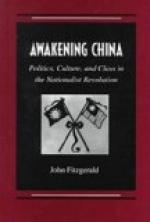Mongols of the common classes are clad in dirty sheepskins. Their gentry and priesthood dress themselves in the spoils of wolf or fox—more costly but not more clean. Furs, felt, and woollen fabrics of the coarsest texture may also be noticed. Raiment of camel’s hair, strapped with a leathern girdle after the manner of John the Baptist, may be seen any day, and the wearers are not regarded as objects of commiseration.
Their camel, too, is wonderfully adapted to its habitat. Provided with two humps, it carries a natural saddle; and, clothed in long wool, yellow, brown or black, it looks in winter a lordly beast. Its fleece is never shorn, but is shed in summer. At that season the poor naked animal is the most pitiable of creatures. In the absence of railways and carriage roads, it fills the place of the ship of the desert and performs the heaviest tasks, such as the transporting of coals and salt. Most docile of slaves, at a word from its master it kneels down and quietly accepts its burden.
At Peking there is a lamasary where four hundred Mongol monks are maintained in idleness at the expense of the Emperor. Their manners are those of highwaymen. They have been known to lay rough [Page 61] hands on visitors in order to extort a charitable dole; and, if rumour may be trusted, their morals are far from exemplary.
My knowledge of the Mongols is derived chiefly from what I have seen of them in Peking. I have also had a glimpse of their country at Kalgan, beyond the Great Wall. A few lines from a caravan song by the Rev. Mark Williams give a picture of a long journey by those slow coaches:
“Inching along, we are inching along,
At the pace of a snail, we are inching
along,
Our horses are hardy, our camels are strong,
We all shall reach Urga by inching along.
“The things that are common, all men will
despise;
But these in the desert we most highly
prize.
For water is worth more than huge bags
of gold
And argols than diamonds of value untold.”
—A Flight for
Life, Pilgrim Press, Boston.
Politically Turkestan is not Mongolia, but Tamerlane, though born there, was a Mongol. His descendants were the Moguls of India. At different epochs peoples called Turks and Huns have wandered over the Mongolian plateau, and Mongols have swept over Turkestan. To draw a line of demarcation is neither easy nor important. In the Turkestan of to-day the majority of the people follow the prophet of Mecca. Russia has absorbed most of the khanates, and has tried more than once to encroach on portions belonging to China. In one instance she was foiled and compelled to disgorge by the courage of Viceroy Chang, a story which I reserve for the sequel. The coveted region was Ili, and Russia’s pretext for crossing the [Page 62] boundary was the chronic state of warfare in which the inhabitants existed.




